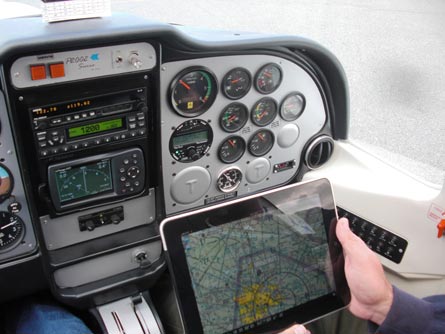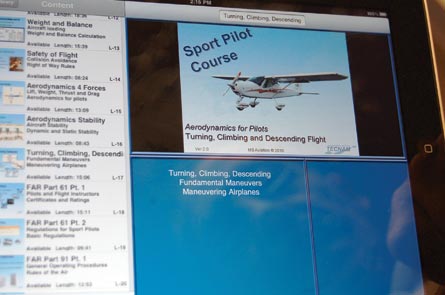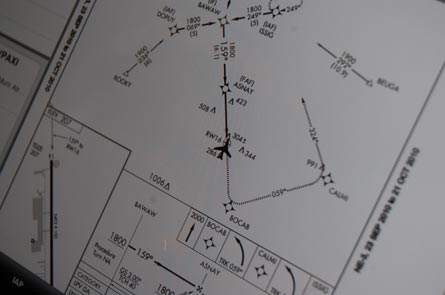A small team of pilots and engineers working for Tecnam North America, the US distributor for the Italian light aircraft company of the same name, will soon turn the tried and true notion of the electronic flight bag on its ear. Training, too, may never be the same.
EFBs, portable computers that can be integrated with an aircraft's avionics suite or used as standalones, by and large have performed the useful function of converting all the paper products that pilots carry to electronic format and performing various other computational tasks, such as weight and balance or landing distance computations.
The introduction of Apple's iPad on the consumer market in April, however, has created a sea change to the notions about what is possible.
|
|---|
"We looked at the iPad initially as being a tool to attract students to Tecnam, a way for us to differentiate Tecnam from other flight schools and suppliers or aircraft," says Ray Swanson, vice-president of distribution and avionics for Tecnam NA. "Now we think it will have a life of its own. This is really the first time the hardware has come together at the right price and performance to allow for multimedia instruction, flight planning, student tracking and reviewing on an all-colour, highly mobile graphical platform."
Combined with Tecnam's custom-designed software, downloaded to the device from the iTunes store, the iPad will become the glue that holds together the seven flight training services of Tecnam NA in Virginia, Ohio and California by this time next year.
"An EFB is a well-organised database of charts and documents," says Dave Lubore, vice-president of flight training services for Tecnam NA. "The iPad, however, integrates all the tools, including continuing learning."
Tecnam has teamed with Tampa-based Enlightened Development to reinvent the learning process for flight training using the iPad, starting with the sport pilot and private pilot licences at its flight centres. Tecnam is selling five Rotax-powered light sport aircraft in the US market, along with the twin-engined Rotax-powered P2006T, which is undergoing final US Federal Aviation Administration validation. All of Tecnam's models are certificated by the European Aviation Safety Agency.
Using the sport pilot's licence as an example, traditional flight training programmes typically involve the student using books to study for written tests, potentially augmented by instructor-led classes. For flight training, the student reviews lesson plans on paper, followed by in-flight review of manoeuvres led by the instructor, who is typically working from a written list or memory.
After the flight, the student, who is typically fatigued from the lesson, sits with the instructor to review his or her performance, based on instructor written notes or memory.
Under the iPad-based programme, flight training will, by the third quarter next year, work differently. Students will sign up and get a flight training package with headphones and a $600 iPad with wi-fi and 3G connectivity (a $430 version with wi-fi will also work, but for the ground school portion only). The iPad will be preloaded with custom-designed training materials and supporting information that can be downloaded from the iTunes store (Windows mobile and Android applications through Amazon.com will also be available soon).
Pre-work for lessons will include multimedia audio and video presentations - footage of flight manoeuvres made by Tecnam NA, for example - using a split screen format to display flight parameters such as airspeed and angle of attack and video through the forward and side windows.
Students will also use the iPad for planning a route and checking weather using publicly available WingX and ForeFlight software programs, aids that can also be used during the flight for charts and situational awareness tools. Course content has been developed by California-based MS Aviation and customised for Tecnam's applications.
During the flight, the instructor uses his own iPad to see what is on tap for the lesson and to grade the manoeuvres using electronic notes in real time. A ground-based server, located at Enlightened Development's facilities, holds grading and progress reports for all students at the school and is upgraded through terrestrial wireless networks when the aircraft lands.
Flight International tested an early version of the flight training regime on the ground and in flight using a Tecnam P2002 Sierra light sport aircraft at Tecnam NA's Hanover County, Virginia flight training school. While the ground school portion of the sport pilot's licence was installed on the iPad, the in-flight aids were limited to navigation programmes.
Regardless, the iPad looked to be an excellent fit for both the pre-flight and in-flight regimes, with the on-screen finger-controlled zoom and de-zoom function a great improvement for manipulating charts. Tecnam does not have a mounting device for the iPad such as a kneeboard of rigid side mount, but we found this did not affect the utility of the iPad in flight.
In fact, being able to place the iPad in any location or orientation may be optimal given that its limited screen brightness can be a challenge for aircraft that have canopies with little structure to block incoming sunlight.
Post-landing should also be more valuable to students under Tecnam NA's plan. After the flight, the student or instructor will eject the removable SD card from the Tecnam aircraft's avionics system and upload the data to the server and download wirelessly back to the iPad.
The intermediate step of going to the server first will be eliminated when Apple allows for media to be uploaded externally to the iPad, an upgrade Enlightened Development's chief executive and chief technology officer Mike Wilson expects by the end of the year or in the first quarter of 2011. Once the flight data is uploaded, the student and instructor will review the flight on the iPad through the X-Plane simulation program, comparing the performance with what the student observed in the pre-flight phase, including the video preparation.
|
|---|
Wilson - formerly director of flight standards for Delta Connection Academy in Sanford, Florida and now the chief flight instructor and director of flight training for Naples, Florida-based Europe-American Aviation - calls the advance "anywhere" learning technology.
"We've taken content normally distributed on DVD and online and put it in a concise package that can be delivered anywhere in the world," says Wilson. "You don't need an internet connect, other than to get the content, and after that, I can listen to an instrument flight training course, for example, while I drive."
To date, Europe-American Aviation has successfully tested the iPad, iPhone and iPod mobile training system with more than 20 students for ground school instruction, says Wilson, adding that worldwide, there are roughly 6,000 users that have downloaded course materials from the Apple online store.
Rather than marketing the materials through traditional avenues such as Sporty's Pilot Shop, Wilson says he has been able to use viral networking and the listing in the Apple store to make the information available.
Tecnam NA has five students trying iPads for light sport pilot and private pilot ground training, with most using an Enlightened Development web portal, an interim step while officials waited for final approval from Apple to host the applications on its online store for the iPad and iPhone (with operating system 4).
"We're going to offer all students this method once Apple approves the application [for the iStore]," says Lubore. "The ground rules are in place. We're requiring students to use the portal now for the sport and private pilot written test preparations as well as for taking the tests."
By mid-November there will be video-based flight manoeuvres for pre-flight preparations, says Swanson. Additional modules will be added in preparation for full functionality in the third quarter of 2011. The first quarter of 2011 will see additional post-flight playback functions, followed by mobile grading for flight instructors and flight planning functions later in the quarter.
Tecnam NA's Lubore has researched the legality, from a Federal Aviation Administration perspective, of using the iPad as a source of charts for Part 91 flight, and found no obstacles. The device itself, however, may not be a good primary navigation source in-flight as the GPS function tends to be slow to converge on the aircraft's position solution if signal is lost as the unit only tracks four GPS satellites. The iPad may also have operating issues above 11,000ft (3,350m) in unpressurised aircraft because of a lack of cooling air, but such issues, although most likely solvable, are tangential to the primary goals for which Tecnam NA is investing in the iPad programme.
Enlightened Development's Wilson is also keeping an eye on the broader worldwide overall flight training environment, a sector he says could experience "significant changes", in part due to the utility that multimedia devices such as the iPad offer. "I can clearly see that this interactive technology will be able to be used for regional airlines and majors as well," says Wilson. "We're moving it into the next step - the flight portion will be a home run for the education industry."
|
|---|
Source: Flight International


























